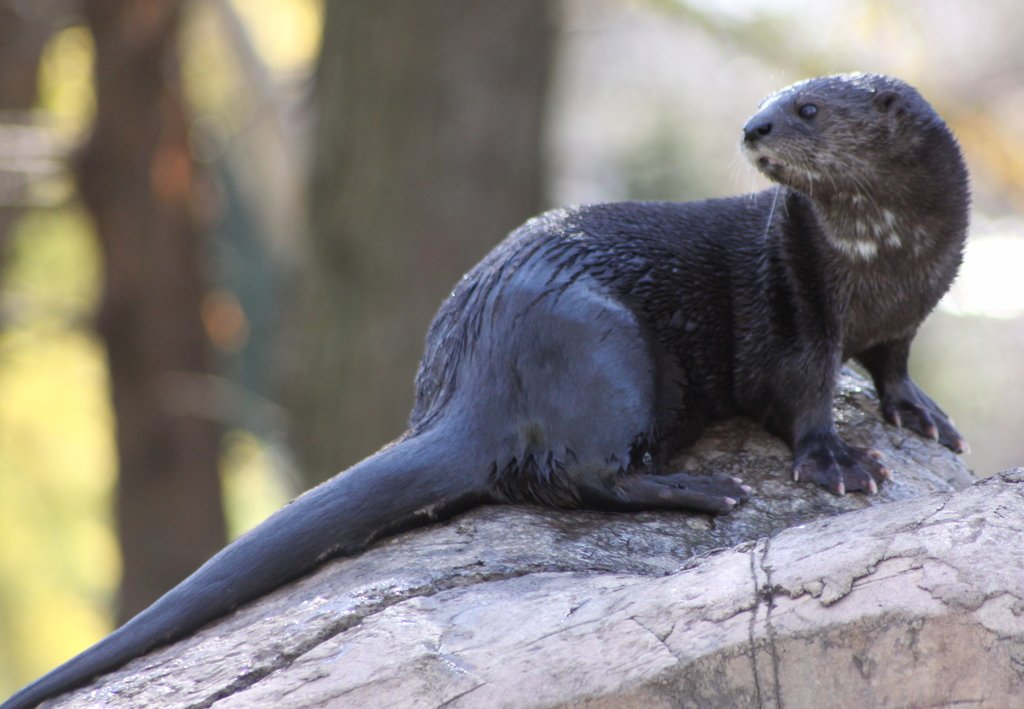Spotted-necked Otter (Hydrictis maculicollis)

©Derek Keates
QUICK GUIDE
SIZE - 0.95 to 1.1 m
WEIGHT - About 9kg
DIET - Fish, amphibians and crustaceans
GESTATION - 9 weeks
OFFSPRING - 1/2 cubs
THREAT TO SPECIES - Nylon fishing nets causing the otter to become entangled and drown.
CONSERVATION STATUS - Near Threatened
The Spotted-necked Otter (Hydrictis maculicollis), or “Water Hyena” as you may hear them called in Africa, is the smallest of the three African otters, and can grow up to 1.1 m in length, and usually to around about 6kg in weight. However, males can reach up to 9kg, as found on Rubondo Island in Lake Victoria, Tanzania, and females can weigh as little as 3kg. They are sleek in appearance with their dark brown fur only broken by prominent light spots on neck, chest and lips. These markings can be used to identify individual otters within groups. Very adapted to the aquatic way of life, the Spotted-necked Otter has well developed webbing and claws, and because of this they appear clumsy on land, often not venturing further than 10 metres from the shore.
©Robert Bannister
Although widely distributed in sub-Saharan Africa, the Spotted-necked Otter’s detailed distribution is not fully understood. They are found in large lakes and rivers up to altitudes of 2500m, yet for some unknown reason they do not appear in the lakes and rivers of East Africa, such as the Zambezi River below Lake Victoria. Until 2003 the Spotted-necked Otter had not been found any further west than Guinea, but a chance recording from a fisherman finding a live animal in his nets in Guinea-Bissau changed this.
The fisherman contacted the IOSF as he was unsure of the species, and following DNA analysis of a single hair it was determined that he had found a Spotted-necked Otter. After further field research, a small population of the species was discovered in this area. Also, in 2010, a sighting was recorded on the lower Orange River of South Africa, which is a mere 1200 kilometres from the next nearest known population of this species.
©Robert Bannister
Spotted-necked Otters tend to live in large single sex groups for most of the year, co-operating in the chasing of fish shoals for their meals. This hunting generally takes place in the day, as the Spotted-necked Otters are diurnal animals. Fish such as cichlids and catfish make up the bulk of the menu, but amphibians, crustaceans, molluscs and even large insects may be taken if the opportunity arises and the hunger is great enough! The Spotted-necked Otter is another intelligent species and can often be found using tools such as rocks to break into shelled prey. Male groups often have home ranges which will cover that of several female otters, with each female group usually made up of mothers and cubs. The adult females will give birth in an underground holt, with one to three cubs at a time being the normal litter size. These cubs will then stay with the mother for around a year. The Spotted-necked Otter has many different grunts, calls and whistles in its vocabulary, allowing the large groups to communicate effectively with one another.
©Dorothy Sutherland
Classed as Near Threatened and decreasing on the IUCN Red List, the future is very unclear for this species of otter. Nylon fishing nets are an issue for the otters, as they often become entangled, which in turn leads to drowning. Although this is generally unintentional by the fishermen, the Spotted-necked Otters are also hunted, as they are involved in ancient traditions. In some places, eating a piece of otter meat, and wearing a piece of skin, is said to increase male virility and make them more attractive to women. They were also hunted for their furs, although this has been regulated since the mid 1970’s. Degradation of habitat is another problem for this species, and this is a common issue with many other species.
However, Spotted-necked Otters have helped to create a positive change in attitudes towards otters. In Kenya, with IOSF funding, locals were able to set up fish farms for tilapia fish, in order to provide food for local people and otters. This has been a perfect resolution where both man and otter can live in harmony.




